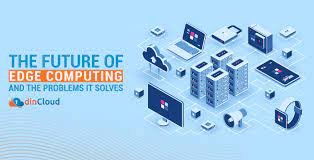Edge computing is rapidly transforming the way businesses process, store, and analyze data by bringing computing power closer to the source of data generation. Unlike traditional cloud computing, which relies on centralized data centers, edge computing distributes computing resources to the edge of the network, enabling faster data processing, reduced latency, and enhanced scalability. As businesses increasingly adopt edge computing technologies, the future of edge computing holds tremendous promise for driving innovation, improving efficiency, and unlocking new opportunities across various industries. In this article, we’ll explore the future of edge computing in business and its potential implications.
1. Enhanced Real-Time Data Processing
One of the key benefits of edge computing is its ability to process data in real-time, closer to where it is generated. This enables businesses to analyze and act on data instantaneously, without the delays associated with sending data to centralized data centers. In the future, edge computing will enable businesses to leverage real-time data processing for applications such as predictive maintenance, remote monitoring, and autonomous decision-making. By harnessing the power of edge computing, businesses can gain valuable insights from their data faster and make more informed decisions in real-time.
2. Improved Data Privacy and Security
Edge computing offers enhanced data privacy and security by processing sensitive data locally, rather than transmitting it over long distances to centralized data centers. This reduces the risk of data breaches and unauthorized access, as sensitive information remains within the confines of the edge devices or edge servers. In the future, businesses will increasingly rely on edge computing to protect their data and ensure compliance with privacy regulations such as GDPR and CCPA. By adopting edge computing technologies, businesses can enhance data privacy and security while maintaining control over their sensitive information.
3. Edge AI and Machine Learning
Edge computing is poised to catalyze the adoption of artificial intelligence (AI) and machine learning (ML) at the edge of the network. By deploying AI and ML algorithms on edge devices or edge servers, businesses can leverage real-time insights and predictive analytics to optimize operations, automate processes, and improve decision-making. In the future, edge AI and ML will enable businesses to deploy intelligent edge applications for a wide range of use cases, including smart manufacturing, autonomous vehicles, and personalized customer experiences. By harnessing the power of edge AI and ML, businesses can unlock new levels of efficiency, innovation, and competitiveness.
4. Edge-to-Cloud Integration
While edge computing offers many benefits, it is not intended to replace cloud computing entirely. Instead, the future of edge computing lies in its integration with cloud computing to create a seamless and hybrid computing environment. Businesses will leverage edge computing for real-time data processing and local analytics, while relying on the cloud for storage, backup, and advanced analytics. Edge-to-cloud integration will enable businesses to leverage the strengths of both edge and cloud computing, combining the low latency and scalability of edge computing with the storage and processing capabilities of the cloud.
5. Industry-Specific Applications
The future of edge computing will see the emergence of industry-specific applications tailored to the unique needs and requirements of various industries. From healthcare and manufacturing to retail and transportation, businesses will deploy edge computing solutions to address specific challenges and opportunities within their respective industries. For example, healthcare providers may use edge computing for remote patient monitoring and telemedicine, while manufacturers may leverage edge computing for predictive maintenance and quality control. By developing industry-specific edge computing applications, businesses can unlock new value propositions, improve operational efficiency, and drive innovation in their industries.
Conclusion
The future of edge computing in business is bright, with tremendous potential to drive innovation, improve efficiency, and unlock new opportunities across various industries. By embracing edge computing technologies, businesses can leverage real-time data processing, enhance data privacy and security, deploy edge AI and machine learning capabilities, integrate edge-to-cloud solutions, and develop industry-specific applications tailored to their unique needs. As businesses continue to adopt edge computing technologies, they will gain a competitive edge in the digital economy and pave the way for a more connected, intelligent, and agile future.
FAQs
What is edge computing, and how does it differ from cloud computing?
Edge computing brings computing resources closer to the source of data generation, enabling faster data processing and reduced latency. Unlike cloud computing, which relies on centralized data centers, edge computing distributes computing resources to the edge of the network, allowing for real-time data processing and analysis.
What are some benefits of edge computing for businesses?
Some benefits of edge computing for businesses include enhanced real-time data processing, improved data privacy and security, deployment of edge AI and machine learning capabilities, integration with cloud computing, and development of industry-specific applications tailored to the unique needs of various industries.
How does edge computing enhance data privacy and security?
Edge computing enhances data privacy and security by processing sensitive data locally, rather than transmitting it over long distances to centralized data centers. This reduces the risk of data breaches and unauthorized access, as sensitive information remains within the confines of the edge devices or edge servers.
What role does edge AI and machine learning play in the future of edge computing?
Edge AI and machine learning enable businesses to deploy intelligent edge applications for real-time insights, predictive analytics, and autonomous decision-making. By leveraging edge AI and ML capabilities, businesses can optimize operations, automate processes, and improve decision-making at the edge of the network.
How will edge-to-cloud integration shape the future of edge computing?
Edge-to-cloud integration will create a seamless and hybrid computing environment, combining the strengths of both edge and cloud computing. Businesses will leverage edge computing for real-time data processing and local analytics, while relying on the cloud for storage, backup, and advanced analytics, unlocking new levels of efficiency and scalability.














Greetings of the Day.
Hey, Kaifi Ahmad.
Thanks a lot for your lovable Information. Really i liked it. Keep on posting.